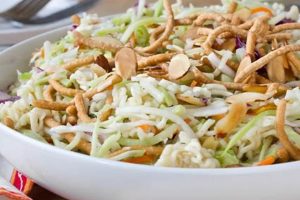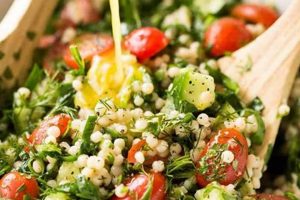Small pasta granules of semolina wheat, couscous serves as a versatile base for a wide array of salads. These salads often incorporate fresh vegetables, herbs, dried fruits, nuts, and various protein sources like chickpeas, grilled chicken, or fish. A simple lemon vinaigrette or a more complex herbed dressing typically complements the other ingredients.
Light yet satisfying, these dishes offer a nutritious and convenient meal option. The quick-cooking nature of couscous makes it ideal for weeknight dinners or packed lunches. Its neutral flavor profile readily absorbs the flavors of accompanying ingredients, allowing for diverse flavor combinations suited to various palates and dietary preferences. Historically a staple in North African cuisine, it has gained global popularity due to its nutritional value and adaptability.
Further exploration of this culinary theme might include examining specific regional variations, nutritional benefits of particular ingredient combinations, or techniques for achieving optimal couscous texture and flavor.
Tips for Creating Exceptional Couscous Salads
Achieving optimal flavor and texture in a couscous salad involves attention to several key details. The following tips offer guidance for creating dishes that are both delicious and visually appealing.
Tip 1: Toast the Couscous: Toasting couscous in a dry pan before hydrating it enhances its nutty flavor and prevents a gummy texture.
Tip 2: Fluff with a Fork: Once cooked, fluffing the couscous with a fork ensures light and separated grains, preventing clumping.
Tip 3: Balance Flavors and Textures: Incorporate a variety of ingredients to achieve a balance of flavors and textures. Consider crunchy vegetables, creamy cheeses, chewy dried fruits, and flavorful herbs.
Tip 4: Dress While Warm: Adding the dressing while the couscous is still warm allows it to absorb flavors more effectively.
Tip 5: Season Appropriately: Seasoning each component individually, as well as the final salad, ensures a well-developed flavor profile.
Tip 6: Chill Before Serving (Optional): Chilling the salad for a short time allows the flavors to meld, although serving it immediately also presents a desirable freshness.
Tip 7: Garnish Thoughtfully: A final garnish of fresh herbs, toasted nuts, or a sprinkle of spice adds visual appeal and elevates the overall dining experience.
By following these guidelines, one can consistently produce couscous salads that are both flavorful and satisfying. These techniques contribute to dishes suitable for various occasions, from casual meals to more formal gatherings.
With these tips in mind, the following section will explore various recipe variations to further inspire culinary creativity.
1. Couscous Variety (Pearl, Israeli)
Couscous variety significantly influences the final character of a couscous salad. While both pearl couscous and Israeli couscous derive from semolina wheat, their size and texture contribute distinct qualities to the finished dish. Pearl couscous, the smaller and more readily available variety, cooks quickly and offers a light, delicate texture, making it suitable for salads with lighter, brighter flavors. Its small size allows it to readily absorb dressings and blend seamlessly with other ingredients. Israeli couscous, also known as giant couscous, provides a chewier, more substantial base. Its larger size and nuttier flavor make it well-suited for salads featuring roasted vegetables, bolder spices, and heartier proteins. This variety holds its shape well and adds a satisfying textural element.
Consider a summer salad with pearl couscous, chopped cucumbers, tomatoes, feta cheese, and a lemon-herb vinaigrette. The small couscous grains absorb the bright vinaigrette, creating a refreshing and light dish. Conversely, imagine an autumn salad with Israeli couscous, roasted butternut squash, toasted pecans, dried cranberries, and a maple-balsamic dressing. The larger couscous stands up to the robust flavors and textures, resulting in a heartier, more substantial meal.
Understanding these distinctions allows for informed decisions regarding ingredient pairings and overall flavor profiles. Choosing the appropriate couscous variety enhances the culinary experience and contributes to a well-balanced and satisfying salad. Careful selection ensures that the couscous complements, rather than competes with, the other components of the dish, contributing to a harmonious and enjoyable culinary creation.
2. Fresh, Seasonal Vegetables
The incorporation of fresh, seasonal vegetables elevates couscous salads from simple meals to vibrant, flavorful experiences. Seasonality ensures optimal flavor and nutritional value, contributing significantly to both taste and health benefits. Selecting produce at its peak ripeness guarantees the most robust and nuanced flavors, enhancing the overall culinary experience.
- Flavor Enhancement
Seasonal vegetables, harvested at their peak ripeness, offer the most intense and complex flavors. In a couscous salad, this translates to a brighter, more vibrant taste experience. For example, incorporating ripe summer tomatoes adds a burst of sweetness and acidity, while autumnal butternut squash lends earthy sweetness and depth.
- Nutritional Value
Vegetables at their peak seasonality often boast higher nutrient content. Including these in a couscous salad maximizes the dish’s health benefits. Spring asparagus, rich in vitamins K and A, contributes not only flavor but also valuable micronutrients.
- Textural Variation
Different vegetables offer a wide range of textures, creating a more dynamic and engaging culinary experience. Crisp cucumbers provide a refreshing crunch, while roasted root vegetables offer a satisfyingly tender texture. This interplay of textures adds depth and complexity to the salad.
- Visual Appeal
The vibrant colors of fresh, seasonal vegetables contribute significantly to a visually appealing presentation. A salad featuring a mix of colorful bell peppers, deep green spinach, and bright orange carrots is not only flavorful but also aesthetically pleasing. The visual appeal enhances the dining experience and stimulates the appetite.
By prioritizing fresh, seasonal vegetables, one can create couscous salads that are not only delicious and nutritious but also visually appealing. This approach ensures that each salad reflects the best of what each season has to offer, resulting in a dynamic and satisfying culinary experience that celebrates both flavor and healthful eating.
3. Complementary Protein Sources
Protein plays a crucial role in a balanced diet, and incorporating complementary protein sources into couscous salads elevates them from side dishes to complete, satisfying meals. Strategic protein choices not only enhance nutritional value but also contribute to texture and flavor complexity, making these salads more appealing and satiating.
- Legumes
Legumes, such as chickpeas, lentils, and black beans, offer a readily available and affordable plant-based protein source. Their earthy flavors and varied textures blend seamlessly with couscous, while their high fiber content contributes to digestive health. Chickpeas, for instance, pair well with Mediterranean-inspired couscous salads featuring cucumbers, tomatoes, and feta cheese.
- Meat and Poultry
Grilled chicken, shredded lamb, or diced turkey breast provide lean protein options that enhance the heartiness of couscous salads. These additions offer diverse flavor profiles and textures, complementing various vegetable and spice combinations. Grilled chicken, seasoned with herbs and spices, pairs well with couscous salads featuring roasted vegetables.
- Fish and Seafood
Flaked salmon, grilled shrimp, or seared tuna introduce omega-3 fatty acids and delicate flavors to couscous salads. These options offer a lighter protein alternative, ideal for warm-weather meals or those seeking a pescatarian diet. Flaked salmon complements couscous salads with dill, lemon, and capers.
- Cheese
While not a complete protein source on its own, cheese contributes protein and adds creamy textures and savory flavors to couscous salads. Feta, crumbled goat cheese, or diced halloumi can enhance the overall profile of the dish. Feta cheese, with its salty tang, complements Mediterranean-inspired couscous salads.
The selection of a complementary protein source depends on individual dietary preferences and desired flavor profiles. Careful consideration of these elements ensures a well-balanced and satisfying couscous salad suitable for various occasions and palates. By incorporating these protein sources, couscous salads transition from simple sides to complete and nutritious meals, offering a diverse range of flavors and textures while contributing essential nutrients to a balanced diet.
4. Flavorful Herbs and Spices
The strategic use of herbs and spices significantly elevates couscous salad from a simple dish to a culinary experience. Their aromatic and flavorful contributions create depth and complexity, transforming the neutral canvas of couscous into a vibrant and nuanced dish. Careful selection and application of these ingredients are essential for achieving balanced and harmonious flavor profiles.
- Fresh Herbs
Fresh herbs, such as mint, parsley, cilantro, and dill, introduce bright, vibrant notes to couscous salads. Their delicate flavors complement fresh vegetables and lighter proteins, creating a refreshing and aromatic experience. Chopped mint adds a cooling element to salads with cucumbers and feta, while parsley complements lemon-herb vinaigrettes. The use of fresh herbs elevates the overall sensory experience, adding a layer of complexity beyond the basic ingredients.
- Dried Spices
Dried spices, including cumin, coriander, paprika, and turmeric, offer deeper, more robust flavors that enhance couscous salads with warm, earthy notes. These spices pair well with roasted vegetables, heartier proteins, and richer dressings. Cumin and coriander add warmth to salads with roasted butternut squash and chickpeas, while smoked paprika lends a smoky depth. The judicious use of dried spices adds layers of complexity and creates a more robust flavor profile.
- Spice Blends
Pre-mixed spice blends, such as ras el hanout or za’atar, offer convenient and complex flavor combinations that enhance couscous salads with unique regional influences. These blends simplify the seasoning process while introducing a diverse range of flavors. Ras el hanout, a North African spice blend, adds warmth and complexity to salads with lamb or chickpeas, while za’atar introduces a Middle Eastern flair. Spice blends provide a shortcut to complex flavor profiles without requiring extensive knowledge of individual spices.
- Balancing Flavors
The key to successful herb and spice integration lies in achieving balance. The goal is to enhance, not overpower, the other ingredients. Start with small amounts and adjust according to personal preference. Consider the overall flavor profile of the salad, ensuring that the chosen herbs and spices complement the other components. A balanced approach ensures that the final dish is harmonious and flavorful, with each ingredient contributing to the overall culinary experience.
By carefully considering the interplay of fresh herbs, dried spices, and spice blends, one can transform a basic couscous salad into a complex and flavorful culinary creation. The strategic use of these ingredients adds depth, aroma, and a unique character to each dish, elevating the dining experience and showcasing the versatility of couscous as a culinary canvas.
5. Balanced Vinaigrettes/Dressings
A balanced vinaigrette or dressing serves as the unifying element in a couscous salad, binding the diverse ingredients and transforming them into a cohesive and flavorful dish. The dressing not only adds moisture and flavor but also enhances the overall textural experience. Its influence extends beyond mere seasoning, impacting the perceived freshness, richness, and overall balance of the salad. A well-crafted dressing elevates the individual components, creating a harmonious and satisfying whole.
The delicate nature of couscous necessitates a dressing that complements rather than overwhelms. An overly acidic vinaigrette can make the couscous taste sour, while an excessively rich dressing can result in a heavy, cloying dish. Balance is achieved through careful consideration of the acidity, sweetness, and oil content of the dressing. A classic lemon vinaigrette, for example, balances the tartness of lemon juice with the richness of olive oil and a touch of sweetness from honey or maple syrup. This balance allows the flavors of the vegetables, herbs, and protein to shine through, while the dressing provides a cohesive backdrop. Similarly, a tahini-based dressing, with its nutty and creamy texture, complements roasted vegetables and spices in a Middle Eastern-inspired couscous salad, providing a rich counterpoint to the earthy flavors.
Achieving the right balance in a vinaigrette directly impacts the overall success of a couscous salad. It influences not only the flavor profile but also the perceived texture and freshness of the dish. A harmonious dressing enhances the individual ingredients, creating a symphony of flavors and textures that delight the palate. This understanding empowers culinary creativity, allowing for the development of dressings tailored to specific ingredient combinations and desired flavor profiles. The result is a couscous salad that is not merely a collection of ingredients but a cohesive and satisfying culinary creation.
Frequently Asked Questions about Couscous Salads
This section addresses common inquiries regarding the preparation and enjoyment of couscous salads, providing clear and concise information to ensure culinary success.
Question 1: What is the optimal cooking method for couscous intended for salads?
The absorption method, using boiling water or broth, is generally preferred for couscous in salads. This method ensures even hydration and prevents overcooking, resulting in light and fluffy couscous. Toasting the couscous in a dry pan before hydration enhances its nutty flavor.
Question 2: Can couscous be prepared in advance for salads?
Couscous can be cooked a day or two in advance and stored refrigerated in an airtight container. Fluff with a fork before incorporating it into the salad to restore its light texture.
Question 3: How can one prevent couscous from becoming gummy or sticky in a salad?
Using the correct liquid-to-couscous ratio and avoiding overcooking are crucial. Fluffing the couscous with a fork after cooking and allowing it to cool slightly before adding the dressing also helps prevent stickiness.
Question 4: What are some suitable protein pairings for couscous salads?
Versatile protein options include grilled chicken or fish, chickpeas, lentils, or feta cheese. The choice depends on individual dietary preferences and desired flavor profiles.
Question 5: How can one enhance the flavor profile of a basic couscous salad?
Fresh herbs, spices, and a balanced vinaigrette or dressing significantly enhance the flavor profile. Toasted nuts or dried fruits add textural complexity and sweetness.
Question 6: Are there specific considerations for creating vegan or gluten-free couscous salads?
While traditional couscous is not gluten-free, gluten-free couscous alternatives are available. For vegan options, ensure all ingredients, including the dressing, are plant-based. Many flavorful vegan dressings can be created with ingredients like tahini, lemon juice, and maple syrup.
Understanding these fundamental aspects of couscous salad preparation empowers individuals to create delicious and satisfying meals tailored to specific dietary needs and preferences.
The subsequent section will provide a curated selection of diverse and inspiring couscous salad recipes.
Couscous Salad Recipes
Exploration of couscous salad recipes reveals a versatile culinary landscape. From the selection of couscous varieties to the incorporation of fresh, seasonal vegetables, complementary proteins, flavorful herbs and spices, and balanced dressings, each element contributes significantly to the final dish. Understanding these components allows for informed choices that cater to diverse palates and dietary preferences. The adaptability of couscous as a base ingredient facilitates endless culinary creativity, enabling the creation of salads ranging from light and refreshing to hearty and substantial.
The potential of couscous in culinary applications remains vast. Continued exploration of flavor profiles, textures, and ingredient combinations promises further innovation within this culinary realm. An enhanced understanding of the core principles outlined herein empowers individuals to create nutritious, flavorful, and visually appealing couscous salads suitable for any occasion.






